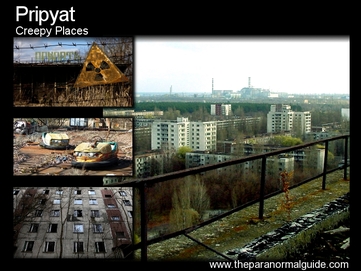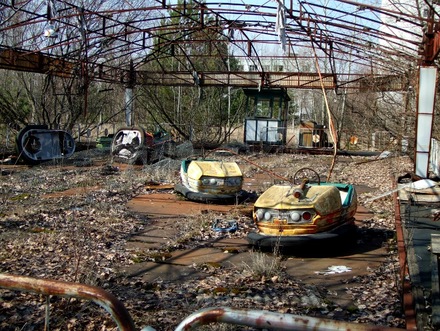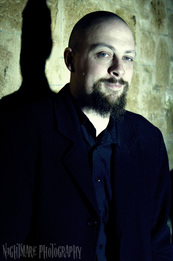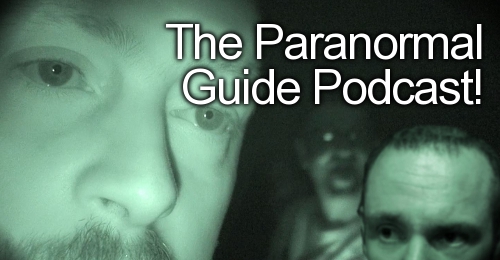
It still, silently, stands empty to this day.
Mass Evacuation
 Pripyat with Chernobyl in the distance.
Pripyat with Chernobyl in the distance. Nearby, much of the population of the city of Pripyat slept, many of those who were awake, were oblivious to the nuclear tragedy unfolding a few kilometres away.
The following day, as radioactive materials continued to fall over the city and much of the countryside, the residents of Pripyat went about their regular business, oblivious to the danger. Soon people began to feel ill, with headaches, nausea, fits and vomiting. The clinics and hospital experienced a sudden surge of patients, with many experiencing a metallic taste in their mouth along with other symptoms.
It was not until the 28th that the citizens were informed of the dangers that had arisen from the nearby explosion, and that they were to be evacuated. It took nearly two days for the city to be emptied.
As the citizens were told the evacuation was only to be temporary, they left most of their belongings behind. They were never to return, and the city now stands as a crumbling monument of the Soviet Unions 9th Nuclear City.
Remnants of a City
 Pripyat abandoned.
Pripyat abandoned. It was proclaimed as a city in 1979, and by 1986 it had a population of around 49,000 people, with the number expected to almost double within a few decades.
The city had all the infrastructure one would expect of a population centre of its size; 15 primary schools, 5 secondary schools, a hospital and several clinics, stores, malls, cafes, restaurants, a hotel, stadiums, gymnasiums, public pools, playgrounds, factories and most iconic of all, its small amusement park, complete with bumper cars and a Ferris wheel.
It had a young population, with the average age being twenty six.
 Everything was left as it lay.
Everything was left as it lay. Tours are conducted through the ghost city, as the radiation levels are not high enough to be a health risk, except for those who stay for weeks rather than hours. A lone guard stands at the gate, which provides access to the city.
However, fenced off and with its 'security', the city was not immune to vandals, as most of the buildings have been completely ransacked, and anything of value was removed. At times people have been found trying to survive in the ruins, as after all a roof over your head, no matter how dangerous it is, can seem to be much better than being out on the streets for some.
Although the city did not directly see deaths as a result of the disaster, many later died from cancers and other complications arising from their exposure to fallout. During its time as a working city it did have deaths from accidents and sickness, but no more than any other populace of its size.
Still, many ghost stories have popped up.
Ghosts Amongst the Decay
 Are the buildings empty???
Are the buildings empty??? Someone or something has been collecting them and turning otherwise empty rooms into children's play areas. Many believe it is the young spirits doing this.
Any contact with these children spirits seems to be interactive and intelligent, with many visitors saying they are definitely being watched about the ruins.
Other apparitions, including those of workers, fire fighters and medical teams, have also been reported. These generally disappear when approached, and are classified as being residual. Possibly the radioactive nature of the site allows a living person to see the dead, or remnants of history be played out more easily.
 Pripyat.
Pripyat. Pripyat will always remain empty, too dangerous to fix and too expensive to demolish. It will always remain for those who wish to experience one of the world’s largest ghost cities. Should you venture there and dare to climb a building to any height, you will be greeted with a distant look of the Chernobyl Power Plant itself, silently standing only a few kilometres away.
Questions for You...
Do you believe the radiation levels could allow ghosts to more easily manifest or allow us to easier see them?
Post your thoughts in the Disqus box below!
(Top tip... I read the comments here and don't really see the ones on Facebook etc..)





 RSS Feed
RSS Feed
